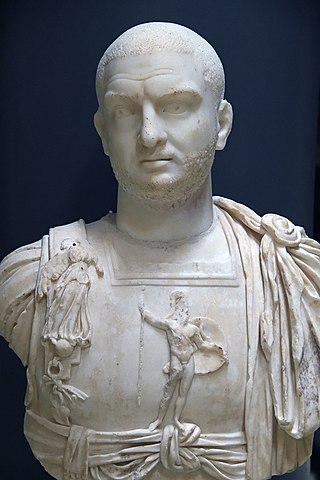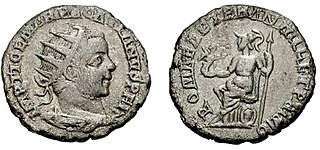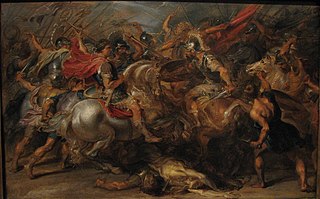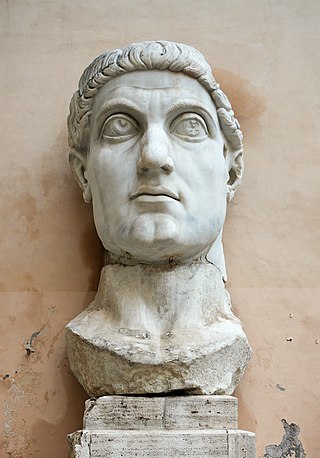Related Research Articles

The Battle of Abritus, also known as the Battle of Forum Terebronii, occurred near Abritus in the Roman province of Moesia Inferior in the summer of 251. It was fought between the Romans and a federation of Gothic and Scythian tribesmen under the Gothic king Cniva. The Roman army of three legions was soundly defeated, and Roman emperors Decius and his son Herennius Etruscus were both killed in battle. They became the first Roman emperors to be killed by a foreign enemy. It was one of the worst defeats suffered by the Roman Empire against the Germanic tribes, rated by the Roman historian Ammianus Marcellinus as on par with the Battle of the Teutoburg Forest in 9 AD, the Marcomannic invasion of Roman Italy in 170, and the Battle of Adrianople in 378.
The 240s decade ran from January 1, 240, to December 31, 249.

Year 249 (CCXLIX) was a common year starting on Monday of the Julian calendar. At the time, it was known as the Year of the Consulship of Gavius and Aquilinus. The denomination 249 for this year has been used since the early medieval period, when the Anno Domini calendar era became the prevalent method in Europe for naming years.

Gaius Messius Quintus Trajanus Decius, sometimes translated as Trajan Decius, was Roman emperor from 249 to 251.

Marcus Aurelius Valerius Maxentius was a Roman emperor from 306 until his death in 312. Despite ruling in Italy and North Africa, and having the recognition of the Senate in Rome, he was not recognized as a legitimate emperor by his fellow emperors.

Philip the Arab was Roman emperor from 244 to 249. He was born in Aurantis, Arabia, in a city situated in modern-day Syria. After the death of Gordian III in February 244, Philip, who had been Praetorian prefect, achieved power. He quickly negotiated peace with the Persian Sassanid Empire and returned to Rome to be confirmed by the Senate. During his reign, the city of Rome celebrated its millennium.

Gaius Vibius Trebonianus Gallus was Roman emperor from June 251 to August 253, in a joint rule with his son Volusianus.

Marcus Aemilius Aemilianus, also known as Aemilian, was Roman emperor for three months in 253.

Quintus Herennius Etruscus Messius Decius, known simply as Herennius Etruscus, was briefly Roman emperor in 251, ruling jointly under his father Decius. His father was proclaimed emperor by his troops in September 249 while in Pannonia and Moesia, in opposition to Philip. Decius defeated Philip in battle, and was then proclaimed emperor by the Senate. Etruscus, still a child, was elevated to Caesar (heir) in 250, then further raised to Augustus (emperor) in May 251. When the Goths, under Cniva, invaded the Danubian provinces, he was sent with a vanguard, followed by the main body of Roman troops, led by Decius. They ambushed Cniva at the Battle of Nicopolis ad Istrum in 250, routing him, before being ambushed and routed themselves at the Battle of Beroe. Etruscus was killed in the Battle of Abritus the following year, alongside his father. After the deaths of both emperors, Trebonianus Gallus, who had been governor of Moesia, was elected emperor by the remaining Roman forces.

Pacatian was a usurper in the Danube area of the Roman Empire during the time of Philip the Arab.

Gaius Vibius Volusianus was a Roman emperor from 251 to 253, ruling with his father Trebonianus Gallus.

The Carpi or Carpiani were a Dacian tribe that resided in the eastern parts of modern Romania in the historical region of Moldavia from no later than c. AD 140 and until at least AD 318.

The Battle of Chrysopolis was fought on 18 September 324 at Chrysopolis, near Chalcedon, between the two Roman emperors Constantine I and Licinius. The battle was the final encounter between the two emperors. After his navy's defeat in the Battle of the Hellespont, Licinius withdrew his forces from the city of Byzantium across the Bosphorus to Chalcedon in Bithynia. Constantine followed, and won the subsequent battle. This left Constantine as the sole emperor, ending the period of the Tetrarchy.
The Gothic wars or Roman–Gothic wars were a long series of conflicts between the Goths and the Roman Empire between the years 249 and 554 AD. The main wars are detailed below.

The Battle of Verona was fought in 312 between the forces of the Roman emperors Constantine I and Maxentius. Maxentius' forces were defeated, and Ruricius Pompeianus, the most senior Maxentian commander, was killed in the fighting.

The Gothic War took place between the years 248 and 249, as well as in the year 253. Within this war, a series of battles occurred and plundering was carried out by the Goths and their allies in the eastern territory of the Roman Empire, specifically in the Balkans. With the cessation of the payment of tribute previously made by the Roman emperor Philip the Arab to the tribes beyond the Danube, the Goths and their allies, led by King Ostrogotha and his subcommanders Argedo and Gundericus, moved towards the Roman border and began a series of attacks, including against the fortified city of Marcianopolis in Thracia. After these actions, the Goths withdrew with their spoils of war.

The Battle of Brescia was a confrontation that took place during the summer of 312, between the Roman emperors Constantine the Great and Maxentius in the town of Brescia, in northern Italy. Maxentius declared war on Constantine on the grounds that he wanted to avenge the death of his father Maximian, who had committed suicide after being defeated by him. Constantine would respond with a massive invasion of Italy.

The siege of Segusio or siege of Susa was the first clash of the civil war between the Roman emperors Constantine the Great and Maxentius in the spring of 312. In that year, Maxentius had declared war on Constantine, claiming to intend to avenge the death of his father Maximian, who had committed suicide after being defeated by him. Constantine would respond with an invasion of northern Italy.
References
- ↑ Southern, Pat (2001). The Roman Empire from Severus to Constantine. London New York: Routledge. pp. 73–74. ISBN 9780415239431. OCLC 46421874.
- ↑ Bowman, Alan; Cameron, Averil; Garnsey, Peter, eds. (2005-09-08). The Cambridge Ancient History. Vol. 12, The crisis of Empire, AD 193–337. Cambridge University Press. p. 38. doi:10.1017/chol9780521301992. ISBN 9781139053921. OCLC 828737952.
- ↑ Zosimus, Historia Nova 1.22
- ↑ Whitworth, Patrick (2018-09-01). Suffering and Glory: The Church from the Apostles to Constantine. Sacristy Press. p. 213. ISBN 978-1-910519-92-9.